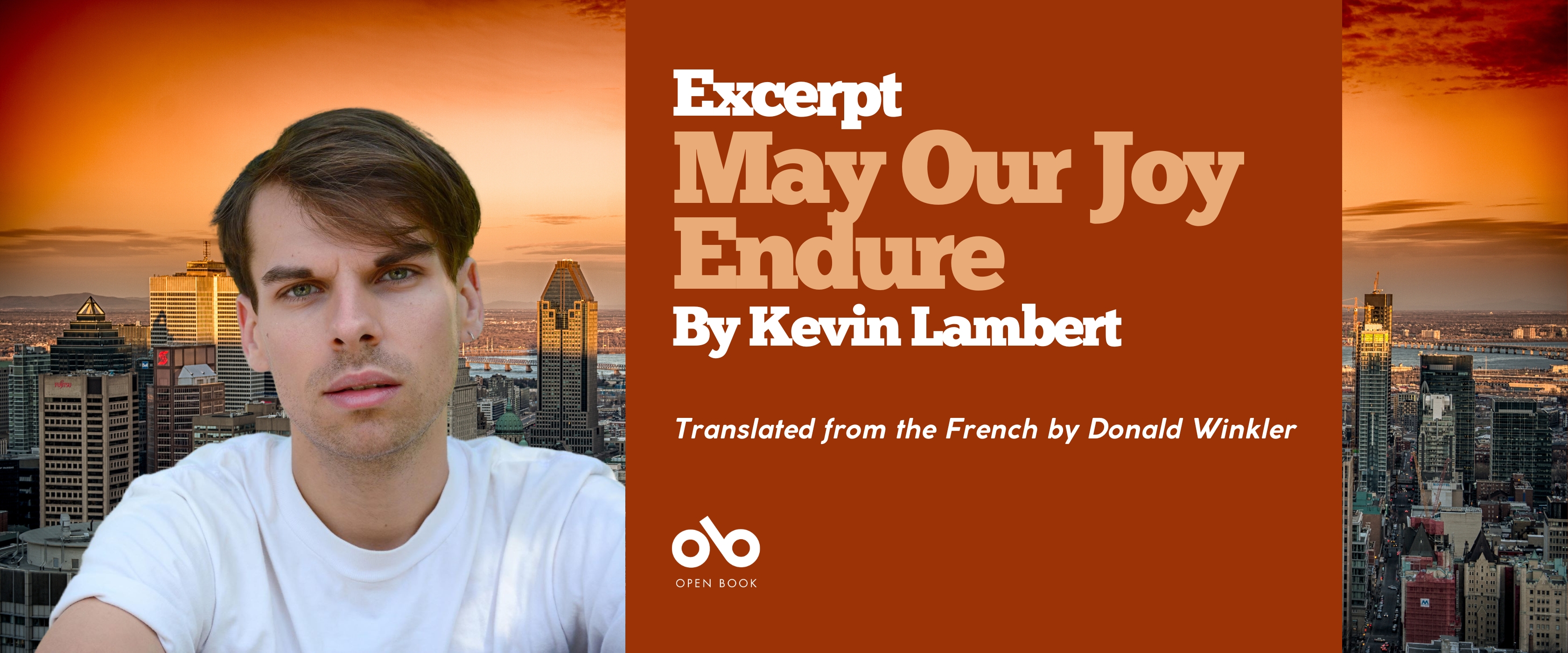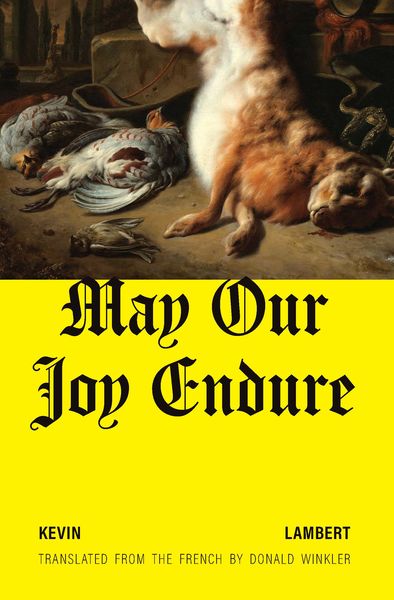Read an Excerpt from May Our Joy Endure by Kevin Lambert, Translated From the French by Donald Winkler
The previous works from Kevin Lambert have garnered broad acclaim across the literary landscape, along with awards wins and nominations. It will come as no surprise to familiar readers that the latest novel from the author has already been celebrated in it's original French edition as the winner of the 2023 Prix Médicis, Prix Décembre, and Prix Ringuet.
May Our Joy Endure (Biblioasis) is another stunner from Lambert. The novel follows internationally renowned architect and accidental digital-culture icon Céline Wachowski, as she plans a new megaproject in Montreal. The WeBuy Complex is supposed to be her hometown triumph, but it is quickly ripped to shreds in the public eye by the local community and by other critics of egregious builds that actually destroy functional urban spaces. When she is deposed as the CEO of her firm. the protagonist finds her world upended, and has to reckon with the evils of the elite in her circle, and their potentially tenuous position in society.
Read on further about this captivating story, and the ruthless and brilliant Céline Wachowski in this excerpt from Lambert's new novel.
May Our Joy Endure by Kevin Lambert, translated by Donald Winkler
Part Two, Chapter One
Webuy had chosen Ateliers C/W for its new Montreal headquarters, but it was not the project of Céline Wachowski’s dreams. She had wanted to give the city its Place des Arts, its Grande Bibliothèque, its Champlain Bridge, one of its universities, or one of its skyscrapers, she wanted to sign her name to an iconic building that would reflect both her eminence and the city’s reputation, a building that would attract tourists from around the world and seal the bond between the city and its foremost architect. She had dreamed at the start of her career of being the name one associated instinctively with Montreal, like Corbusier with Chandigarh or Mies van der Rohe with Chicago. She laboured, following what the specialists call her “residential period,” to endow all her constructions with a powerful, attractive aura that would have them figuring in the tourist literature of all the cities where Céline Wachowski had created a major project. Her firm had altered the skyline of San Francisco and made its subtle contribution to those of New York and Bangkok, her museums were among the most visited in Los Angeles and Tokyo, the architecture that interested her, which was at the core of Ateliers C/W’s mission, was an art of the people, was not architecture the weightiest, the most costly, the most politically-dependent, and yet also the most accessible and most democratic form of artistic expression imaginable. A building, Céline wanted to believe, could transform people’s lives, a neighbourhood’s vigour, could insert a little beauty into the daily lives of men and women who came its way, her art demanded considerable resources, but it also had the power to ease the suffering and relieve the monotony of existences, to elicit deep, buried feelings, to give individuals a sense that they were part of something greater than themselves.
Your CanLit News
Subscribe to Open Book’s newsletter to get local book events, literary content, writing tips, and more in your inbox
The site she would oversee in Montreal, one of her last largescale projects before retiring, would be a public-private partnership that would not, however, fit the pattern of what she had imagined. The client did not want to locate himself in the city centre, too dilapidated, too familiar, too touristic in his opinion, “not attractive enough for our workers from San Fran and Seattle.” Webuy was not drawn to the idea of a skyscraper. The new headquarters would be situated outside the tourist circuits and the parts of town that were most frequented. The location had yet to be chosen, but the centre of the city, everything between the river and Avenue Van Horne, unless there were an incredible bargain, was out of the question. Céline had begun her feasibility studies in a state of loss, mourning a vague idea, unfulfilled, and perhaps that much harder to forget in that it had not taken on a concrete form; Céline had embarked on an exhausting quest to trace the ramifications of this faded dream, this phantom structure that had appeared on the horizon of so many other plans. Her sculptures in glass and wood had been built atop the ruins of an old unrealized dream that had been redirected a thousand times, whenever a sale or a demolition reached her ears. The building, despite its multifarious guises, harboured a unity conferred on it by its painful inexistence. The shared feature that united all those mental sketches and drawings jotted down in little notebooks was this absence exactly, this vertiginous negativity; this void in Céline’s creative life was the most salient feature of the imagined monument, a boundless emptiness that weighed on her shoulders and that she carried with her everywhere; her masterpiece existed in the limbo of her imagination, and for this reason it was more substantial than many other structures that Céline had conceived from cellar to attic. And now she had to abandon it all, to start anew. This dream that had had so many different names, so many provisional forms, had to be forgotten. Shapes and articulations sparred inside her head, optics and concepts merged one into the other to form a sad stream of moribund materials, lost glory, and slighted desire. This semi-dream proposed to her today and that she accepted with resignation, this mouth-watering project that made all the international firms green with envy, left her with a raw thirst, a desiccation that no sparkling water proffered by the mayor, the minister of economic development, or the CEO of Webuy in the course of their long meetings, could ever assuage. The company, known for its sleekly designed websites, wanted only Céline Wachowski; if Céline refused the project, it would reassess its decision to install itself in Montreal. The mayor had almost begged her to accept. They’d promised her a great deal of freedom, the contract would be negotiated between the multinational and Ateliers C/W, the city would not be involved. They envisaged an “original” building, a “one of a kind,” “without precedent.” Montreal had been chosen out of all the proposals received, every large North American city had presented a detailed socioeconomic portrait of its territory, valuable demographic details, and other data judged crucial for the company’s future growth. Webuy had settled on Montreal because of the fiscal advantage and generous investments pledged by all levels of government. Their marketing specialists were given the task of defending the decision with extremely flattering arguments, they had strongly supported the candidacy of Céline Wachowski, indisputably the best-known Québécoise in the world, and they had to at all costs bind her to the project one way or the other. The idea had pleased the higher-ups, the storytelling was perfect, a multinational whose reputation might have been better was selecting a third-order city to house its new headquarters and would bestow on the area, beyond supporting its economic and cultural development, an important structure conceived by one of the greatest modern architects, whose personal drama was to have never yet endowed her native city with a building comparable to her stature. A remedial scenario, one of redemption and triumph, was at the heart of this affair, it only had to reach the journalists’ lips for it to be repeated ad infinitum. It would look good, too, that the architect was a woman. Against the initial recommendations of the ministry, which was aware of Ateliers C/W’s intransigent reputation—the civil servants knew that Céline and her team would not lend themselves to a less than exceptional project just to accommodate a government’s restricted budget, and that she always negotiated complex modifications to the rules—the company had capitalized on a clause in the contract stipulating that the choice of architect, engineer, and contractor (these titles were given in the masculine only so as not to weigh down the text) resided with it alone, and it had imposed, without any further debate, Céline Wachowski. After a month of consultations and meetings, the work began. Ateliers C/W buildings were the product of an impressive team of technologists, engineers, consultants, historians, designers, architects specialized in such and such a function, this project was like a drop of dye loosed into a clear liquid, unfurling in its progression through one team and then another, clearing the hurdle of a design review, a final test or study, and one more collective thrust, to attain, in its dilution, its predestined form. Céline knew her program by heart, she had studied all her client’s needs. Late one night, as she was preparing to leave her office, she saw the building’s profile in a cup of tea. She seized a marker and traced a silhouette on the white board. Her hand, trembling, lifted, and then dropped.
___________________________________________
Born in 1992, Kev Lambert grew up in Chicoutimi, Quebec. May Our Joy Endure won the Prix Médicis, Prix Décembre, and Prix Ringuet, and was a finalist for the Prix Goncourt. His second novel, Querelle de Roberval, was acclaimed in Quebec, where it was nominated for four literary prizes; in France, where it was a finalist for the Prix Médicis and Prix Le Monde and won the Prix Sade; and Canada, where it was shortlisted for the Atwood Gibson Writers’ Trust Fiction Prize. His first novel, You Will Love What You Have Killed, also widely acclaimed, won a prize for the best novel from the Saguenay region and was a finalist for Quebec’s Booksellers’ Prize. Lambert lives in Montreal.





